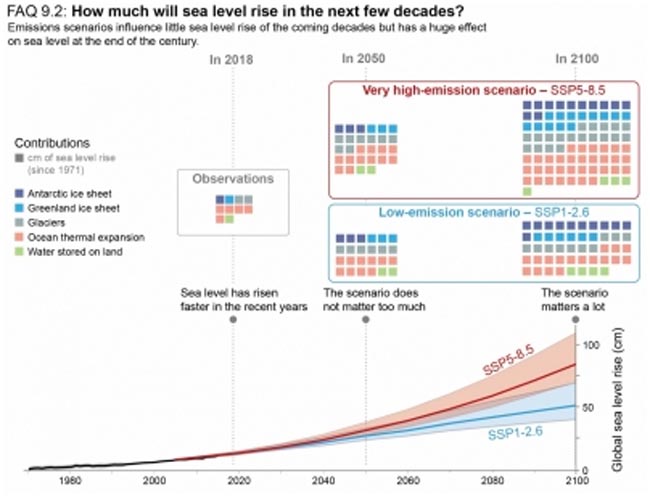
New Delhi, Aug 9:The sea level around Asia has increased faster than the global average, with coastal area loss and shoreline retreat. The sea level extremes that previously occurred once in 100 years could happen once every six to nine years by 2050, and every year by 2100 globally, says Indian Institute of Tropical Meteorology Scientist Swapna Panickal.
Talking to IANS exclusively about findings of the biggest update of the state of knowledge on climate science of the Intergovernmental Panel on Climate Change (IPCC), a United Nations organisation, published on Monday with its impact on India, she said the Indian Ocean is warming at a higher rate than the global oceans.
"Fifty per cent of the sea level rise is contributed by thermal expansion. Hence the sea level over the Indian Ocean region is also rising. The global mean sea level is rising at a rate of around 3.7 millimeter per year that is estimated between 2006 and 2018.
"At 1.5 degrees, the sea temperature is expected to increase by one degree. So, in accordance with that, the global sea level and Indian Ocean sea level is also projected to rise at a similar rate."
According to her, the South and Southeast Asian monsoon has weakened in the second half of the 20th century (high confidence).
"The dominant cause of the observed decrease of South and Southeast Asian monsoon precipitation since the mid-20th century is anthropogenic aerosol forcing. Both annual and summer monsoon precipitation will increase during the 21st century, with enhanced inter-annual variability (medium confidence)," Panickal told IANS in an interview.
She is one of the authors of the IPCC Working Group I report titled "Climate Change 2021: the Physical Science Basis".
She said heat extremes have increased while cold extremes have decreased, and these trends will continue over the coming decades.
According to the report, an increase in annual mean precipitation is projected.
The increase in rainfall will be more severe over southern parts of India. On the southwest coast rainfall could increase by around 20 per cent, relative to 1850-1900.
"If we warm by 4 degrees C, India could see about a 40 per cent increase in precipitation annually," it says.
Citing the report, Panickal said there is a low confidence in long-term (multi-decadal to centennial) trends in the frequency of all-category tropical cyclones.
The tropical cyclone intensity will increase, however, the genesis frequency will decrease or main unchanged.
After a hard two weeks of working across time zones with cooperation by 234 scientists and approved by government representatives from 195 countries, the climate science report covers topics like extreme weather, human attribution, the carbon budget, feedback cycles, and charts the future state of the climate.
According to the IPCC report, the global surface temperature in the first two decades of the 21st century (2001-2020) was 0.99 (0.84-1.10) degree Celsius higher than 1850-1909. Global surface temperature was 1.09 (0.95 to 1.20) degrees higher in 2011�2020 than 1850-1900.
The 1.5 degree goal requires 50 per cent reduction in emissions by 2030 and net zero by 2050.
Climate scientists say the window is short but it can be mobilised by political will and ambition increase.
"It finds that averaged over the next 20 years, global temperature is expected to reach or exceed 1.5 degrees Celsius of warming. It uses a set of five emissions scenarios to explore the impact of a broader range of greenhouse gases, land uses, and air pollutants."
On being asked the main findings of the new report which the world did not know before, she said, "Yes, scientific advances enable AR6 (present report) to better understand and attribute human influence on the climate system. Extreme weather events can be attributed to human-caused climate change with higher certainty.
"For the first time, the Sixth Assessment Report provides a more detailed regional assessment of climate change, including a focus on useful information that can inform risk assessment, adaptation, and other decision-making."
With 7,517 km of coastline, India will face significant threats from rising seas. Across six port cities -- Chennai, Kochi, Kolkata, Mumbai, Surat and Visakhapatnam -- 28.6 million people will be exposed to coastal flooding if sea levels rise 50 cm, according to one study.
